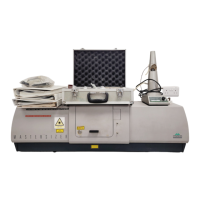However, in most cases the value can be guessed with very little effect on the
result. In practice you will probably only use two values; if the sample is
transparent (glass beads for example) then there will be no absorption so the value
will be 0 (A on the grid), otherwise use 0.1 (H on the grid) as the absorption
value. If you feel you need a more accurate value then it can be calculated by
following the procedure in appendix D.
Finally the fourth character gives the refractive index of the dispersant the sample
is suspended in. As an example, if the sample is suspended in air then the fourth
character will be A (refractive index of air is 1) or if the sample is suspended in
water then the fourth character will be D (refractive index of water is 1.33). Again,
there are many reference books available that state the refractive indices of
materials.
In very rare circumstances you may find that the choice of presentation is critical
to the results and the values on the Malvern presentation grid are not accurate
enough. In this situation a presentation can be generated that use the exact figures
for the refractive index etc.
Methods of selecting a presentation
There are several ways to select a presentation. A presentation is always selected
through the Setup presentation dialogue shown below.
This screen gives you three ways to select a presentation. These options are:
.
The simplest way to select a presentation is to select one of the system pres-
entations À. There is a choice of four presentations usually you will only
use one of the two “standard” presentations.
.
Secondly, if you know the Malvern presentation code you can choose from
the “Select by code” section Á. This lists all available codes that are cur-
rently on the system.
3
1
2
ILL 1872
CHAPTER 5
GETTING STARTED
Page 5.5

